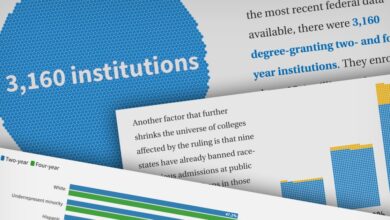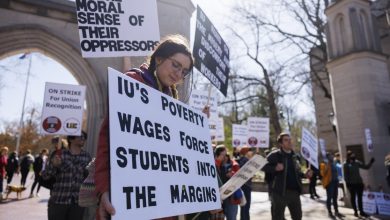Higher Ed’s Labor Shortage Is Easing. But These Parts of Its Work Force Are Struggling to Return to Normal.

Recently revised employment data from the U.S. Bureau of Labor Statistics bore good news for higher ed: The shortfall in jobs had shrunk substantially, from a cumulative deficit of 300,000 jobs lost since February 2020 to fewer than 40,000. Job losses, while still historic, hadn’t been as extensive as the bureau’s original numbers indicated.
Still, 40,000 is a lot of jobs. And institutions are seeing those shortages play out in some common areas, according to reporting in student newspapers, and often for similar reasons like burnout and restlessness, the pressures brought about by increased competition, and a broader rethinking of the role of work in people’s lives.
Dining services have struggled to return to pre-pandemic norms, even as students are back on campus. At Colgate University, The Colgate Maroon-News reported last month, dining services has been operating at half its normal staffing levels since August 2021, and an administrator at the University of Minnesota-Twin Cities told The Minnesota Daily a few weeks ago that turnover among dining staff members there, since a year earlier, had been 41.5 percent. On many campuses, those shortages have meant that dining locations have been closed or operating during limited hours.
It’s difficult to keep dining halls open in part because universities haven’t been able to fill full-time staff jobs, as the University of Arizona’s The Daily Wildcat reported in the winter. But administrators have also had trouble filling open student positions; Ohio University said in February that it expects to spend less than half the money it allocated for student wages this year because of the number of vacant student jobs, from dining to office and library work, according to The Post.
Information technology has been an area of concern, too. At Miami University, in Ohio, the IT office is fielding a quarter to half the number of job applications that it would have before the pandemic, The Miami Student reported. And more than a third of respondents to an Educause QuickPolllast month said they were “strongly considering” leaving their current institution for a position elsewhere. Another 17 percent said they planned to retire soon, and 2 percent had already found work elsewhere.
“It’s not musical chairs, where people are just swapping seats at each other’s institutions. There are a good number of those folks who are considering leaving who aren’t sure if they’re going to stay in higher ed,” said Mark McCormack, senior director of analytics and research at Educause.
IT staff members, McCormack said, are finding that the high-pressure and public role they played in moving campus operations online is leading to burnout, especially if that high-octane role isn’t being backed up with better pay, infrastructure, or other forms of institutional support.
More likely to consider leaving the field, McCormack found in the poll, were those who were “in the middle” — who occupy midlevel managerial positions or who are, perhaps, midcareer, having been in their jobs for six to nine years. “You’re not new anymore,” as McCormack put it. “You don’t have that fresh energy and an optimism of, ‘I’m going to make a difference,’ and, ‘What could my future here hold for me?’ But you’re also not one of the long-term committed staff who’s been deeply rooted there for many, many years.” Instead, one might opt to look for a new job, perhaps one that allowed for more advancement or career-development opportunities.
And when employees leave, that means jobs open up. In many cases, colleges are having trouble filling those posts. “It is a different day,” said Andy Brantley, president and chief executive of the College and University Professional Association for Human Resources. “Positions that used to attract a hundred or more candidates attract zero or just a minimal amount of minimally qualified candidates sometimes.”
Particularly in fields like dining and building services, and IT, where skills are easily transferable across jobs and industries, college campuses are competing with other local employers, many of which are able to offer higher salaries and more job perks. One campus administrator told Brantley recently that their college was competing with “basically every other employer in the community” for such positions. To bring in new employees amid such stiff competition, Brantley has told campus leaders, “we have to be willing to lose our mentality on things like asking all employees to pay to park and things like that, where it makes us less competitive with the private sector.”
In student affairs, exhaustion and burnout have contributed to the state of unrest. A March report by Naspa: Student Affairs Administrators in Higher Education found that 39 percent of survey respondents either didn’t plan to continue to work in student affairs for the next five years or weren’t sure whether they would.
Particularly as open positions become harder to fill, Brantley said, questions of retention and workplace culture are key. “We have to rethink how the work is performed in addition to just thinking, ‘We have all of these vacancies across campus.’”
‘A national conversation’
A broader rethinking is something that Kevin R. McClure, a Chronicle contributor and an associate professor of higher education at the University of North Carolina at Wilmington, also sees happening. “There’s no denying the fact that we are in the midst of a national conversation about working conditions and working cultures, and higher education is part of that conversation,” McClure said. “What that means is that there are folks at institutions that are more directly having conversations about what they’re earning, how many hours they are working. They may feel more emboldened to ask questions and set expectations higher of managers.”
Those conversations may be happening at McClure’s own institution. On Monday, he tweeted about recently released data from the University of North Carolina system on faculty and staff turnover rates, pointing out that staff turnover in the system has spiked in the 2021-22 fiscal year. Between July 2021 and January 2022, according to the data, staff turnover was 77 percent higher than in the same time frame last year.
Why is that? “It may have been the case that initially during the pandemic, people were more likely to stay where they are out of uncertainty, out of safety, and a feeling that the best thing to do is just kind of ride this out,” McClure said. But as the pandemic wore on — even as campuses prepared to reopen in the fall of 2021 — that reasoning may have felt less valid. Brantley, too, sees employees who “hung on to make it through the pandemic” now seeking work elsewhere. That’s why, Brantley said, higher ed is not past the “great resignation” that some pundits have described in the U.S. labor market.
An assessment of the UNC data, which is on the agenda for this week’s meeting of the system’s Board of Governors, notes that the increased turnover rate is “estimated to be a direct outcome of the Covid-19 event and its profound impact on work-force trends.” But to attribute such trends — at UNC and throughout academe — solely to the pandemic rings hollow to McClure. The questions employees are asking now, about workplace culture and how it aligns with their own desires and needs, stem not from Covid-19 but from a higher-ed work environment that existed long before the virus.
For faculty members, such questions have resulted in widespread disengagement with work, as McClure and Alisa Hicklin Fryar wrote in The Chronicle Review. But such a response doesn’t capture the entirety of the staff experience, either, McClure said.
“Some people are leaving, and we shouldn’t downplay that,” he said. “When we actually look at the data, the sheer number of people that are leaving higher education entirely is probably not at tsunami levels.” But more staff members are looking for new roles within their organizations, while others are “taking stock of the place of work in their life, what they prioritize, and, in some cases, refusing or resisting or making a different set of decisions in light of where they land in that re-evaluation.”






